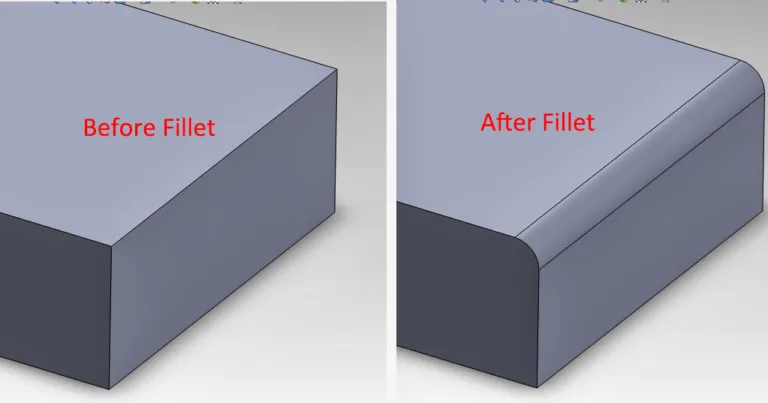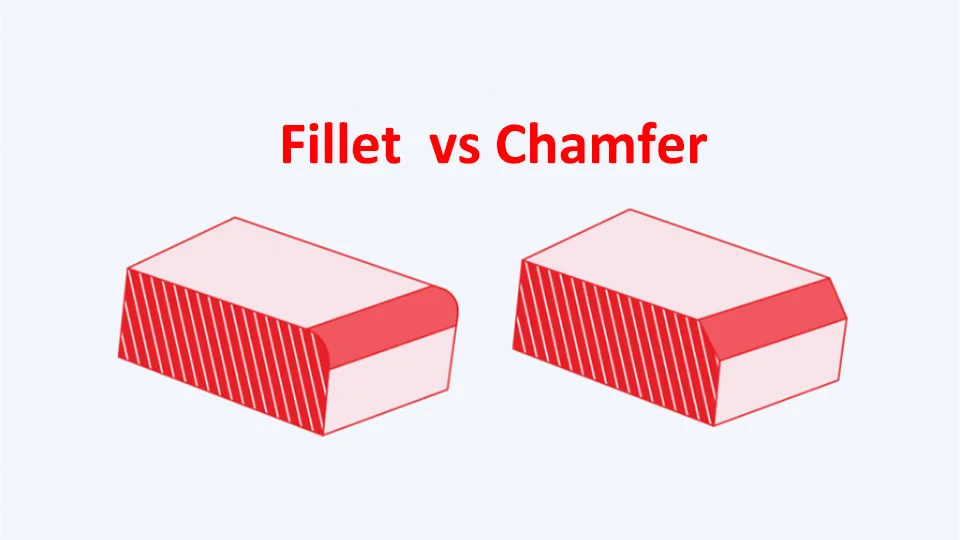Fillets and chamfers are two ways to design the edges where two surfaces of a part meet. Both fillets and chamfers are used to ease sharp edges and corners. Chamfer and fillet design are important in manufacturing, assembling, and using parts. Both design features can reduce stress concentrations and improve custom parts aesthetics. However, there are also many differences between chamfer and fillet. The chamfer is generally easier to manufacture and increases the allowance of mating parts. Fillet is expensive to manufacture but usually safer and more durable. Reading the following blog to learn more about the difference between chamfer and fillet.

What is A Fillet?
In the context of part design and manufacturing, A fillet is a rounded or curved interior corner or edge where two surfaces meet. It is a design feature used to eliminate sharp angles or corners in a part. Fillets are created by blending or curving the intersection of two surfaces, resulting in a smooth transition between them. Fillets are a fundamental design element. It not only enhances the part’s structural integrity but also plays a role in its overall aesthetics and manufacturability. In addition, Machinists often use fillets to eliminate sharp edges that are prone to damage or can cause injury when handling parts.
The Purpose of A Fillet Design
- Stress Reduction: Fillets help distribute stress more evenly across a part, reducing the likelihood of cracks or fractures, particularly in areas with sharp corners.
- Improved Flow: In manufacturing processes like injection molding, fillets can enhance the flow of molten material, reducing the risk of uneven filling and improving the overall quality of the molded part.
- Aesthetics: Fillets contribute to the visual appeal of a part by creating a smoother, more pleasing transition between surfaces.

What is A Chamfer?
A chamfer is a design feature that is a beveled or angled edge between two connecting surfaces of a part. It is usually creating a symmetrical V-shaped groove. This angled edge replaces a sharp corner or right angle, providing several functional and aesthetic benefits in part design and manufacturing. Chamfers are in contrast to fillets. Chamfers do not have a curved shape, it is straight and has a sharp angle. Most chamfers are at 45° or 60°, but a chamfer can be made at any angle. They are generally easier to manufacture and provide specific advantages in terms of assembly and safety.
The Purpose of A Fillet Design
- Ease of Assembly: Chamfers are often used to facilitate the assembly of parts by providing a guide for mating components. The beveled edge makes it easier to align and join parts during the assembly process.
- Safety Improvement: Sharp corners can pose safety risks, and chamfers help mitigate these risks by reducing the likelihood of cuts or injuries when handling or assembling parts.
- Aesthetic Considerations: Chamfers contribute to the overall visual appeal of a part by introducing a beveled edge, adding a touch of sophistication to the design.
- Mating Parts Compatibility: The beveled edge created by a chamfer can increase the allowance between mating parts, improving the fit and reducing the chances of interference during assembly.

When to Use a Fillet and Chamfer?
In part manufacturing, the random use of fillets and chamfers can result in unnecessary processing costs. Knowing when to use chamfers and fillets will help us reduce manufacturing costs and increase the efficiency of our parts.
Add Chamfer to the Hole
For parts with holes where screws or bolts will be inserted, a chamfer is a better choice compared with a fillet. The sharp edge of the chamfer will make smoother pin movement down the hole and easier fastener insertion.
Add Fillet to Edges of the Part
For part edges, especially when safety and stress reduction are priorities, fillets are preferred. They distribute stress, prevent sudden deformation, and eliminate sharp edges.
Add Fillet and Chamfer to Outside Edges
Both fillets and chamfers can be used on part outside edges. When the exterior edge design requirements are not high, you can choose chamfers instead of sharp corners to reduce the risk of injury during use. If your part outside edges aesthetically are important, fillets would be better. It will relieve stress and make the design look better.
Add Chamfer to Mating Parts
Chamfers are better during assembling mating parts. The hole with a chamfered design will make the movement and insertion smoother. Moreover, chamfers of different sizes can be created with one tool.
What is the Difference Between a Fillet and Chamfer?
Here we list the main differences between fillets and chamfers to help you get the desired shape in your part design.
Custom Parts' Safety:
Fillet: Fillets are generally considered safer as they eliminate sharp corners, reducing the risk of cuts or injuries during handling.
Chamfer: Chamfers also contribute to safety by reducing sharp edges, but they may not provide the same level of protection as fillets.
Custom Parts' Application:
Fillet: Fillets are often preferred in applications where stress concentration needs to be minimized, and a smooth transition between surfaces is desired. Common in parts where aesthetics and stress distribution are critical.
Chamfer: Chamfers are commonly used to ease assembly, enhance mating part compatibility, and reduce interference during joining. They are practical for applications where a beveled edge is sufficient.
Manufacturing Cost:
Fillet: Fillets are generally more expensive to manufacture due to the complexity of creating rounded surfaces, especially in precision machining.
Chamfer: Chamfers are typically more cost-effective to produce, making them a practical choice in situations where cost efficiency is a priority.
Machining Time:
Fillet: Machining fillets may require more time due to the intricacies involved in creating curved surfaces, especially in materials that are harder to machine.
Chamfer: Chamfers are generally quicker to machine, especially in processes like milling or turning, where creating beveled edges is relatively straightforward.
Cutting Tools:
Fillet: Fillets may require specialized cutting tools, such as ball end mills, to achieve the desired rounded profiles.
Chamfer: Chamfers can often be machined using standard tools, making the tooling process more straightforward.
Coating:
Fillet: The choice of coating may depend on the material and specific requirements of the fillet. Common coatings include TiN (Titanium Nitride) or TiAlN (Titanium Aluminum Nitride).
Chamfer: Similar to fillets, chamfers may be coated based on the material and specific application. Coatings can enhance tool life and performance.
Stress Concentration:
Fillet: Fillets are effective in reducing stress concentrations, especially in areas with sharp corners, contributing to improved part durability.
Chamfer: Chamfers can also help reduce stress concentrations, but the impact may vary compared to fillets, depending on the design and application.
How to Choose a Fillet and Chamfer?
Choosing between a fillet and chamfer in part design requires careful consideration of various factors to ensure optimal performance, manufacturability, and overall functionality.
Material Properties:
Material Hardness and Brittleness: Consider the hardness and brittleness of the material. Fillets are generally more suitable for softer materials, as they distribute stress more evenly. For harder materials, a chamfer might be preferred to avoid potential cracking.
Material Flow: In processes like injection molding, assess how the material flows. Fillets are beneficial for improving material flow, while chamfers might be chosen for materials that easily fill mold cavities.
Manufacturing Processes:
Machinability: Evaluate the machinability of the material. Fillets might be more challenging due to the need for specialized tools, while chamfers are often easier and more cost-effective.
Tooling Considerations: A single tool can produce chamfers of varying sizes. However, we need to use a radius-specific tool to create a different-size radius.
Machining Time: Comprared with Fillet, a chamfer takes less machining time in a manual operation.
Intended Function of the Part:
Stress Distribution: If the part is subject to stress concentration concerns, especially in load-bearing applications, fillets are preferable. They distribute stress more evenly, enhancing the part’s strength and durability.
Assembly Requirements: Assess the ease of assembly.
Chamfers are advantageous when parts need to be easily assembled, as they provide a guide for smooth movement and insertion.
Fillets may be chosen for parts where stress reduction is critical during assembly.
Safety Considerations: Consider the safety implications, especially for parts that will be handled or assembled by individuals. Fillets are safer in terms of eliminating sharp edges, reducing the risk of injuries during handling.
Aesthetic Consideration:
Visual Appeal: Fillets contribute to a smoother, more rounded appearance, which might be preferred for certain designs. Chamfers, on the other hand, can add a distinct beveled edge for visual interest.
Cost Considerations:
Manufacturing Cost: Consider the overall manufacturing cost. Chamfers are generally more cost-effective to produce, making them a practical choice when cost efficiency is a priority.
Prevent Rust:
The fillet allows coatings and paints to be evenly distributed, so the fillet design prevents parts from accelerated rusting.
Chamfer has a sharp edge and therefore reduces the thickness of the coating. In general, chamfers are not recommended for protective coatings and paints.
Conclusion
Fillets are typically used on corners where parts surfaces meet at a sharp angle. The Chamfers are used on edges where two surfaces meet at an angle. Filets enhance the part’s durability and load-bearing capacity on sharp corners, while chamfers excel in facilitating smooth assembly for mating parts. The careful selection of fillets and chamfers is important, impacting a part’s design, cost-efficiency, longevity, and safety. In this blog, we explained the meaning and difference of fillets and chamfers, discuss the uses and considerations. Contact Zhongde to learn more about fillet and chamfer.
Start A New Project Right Now!
Our sales team will contact you within 24 hours. We are glad to answer your questions.




